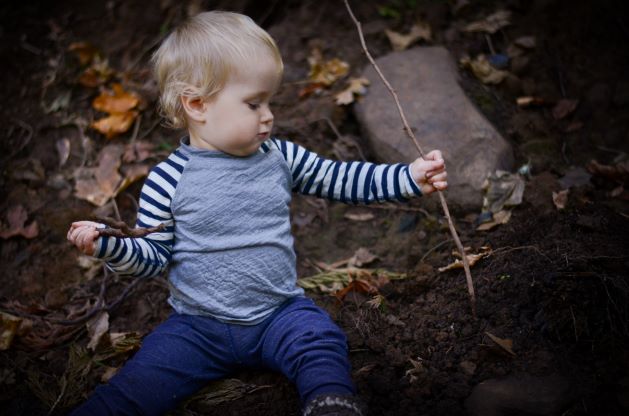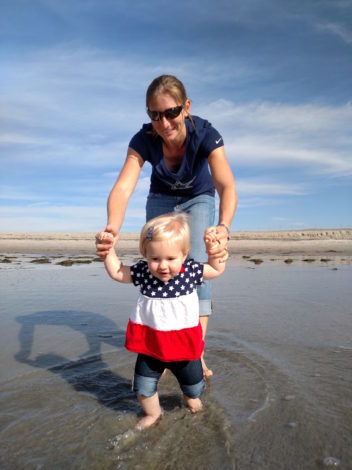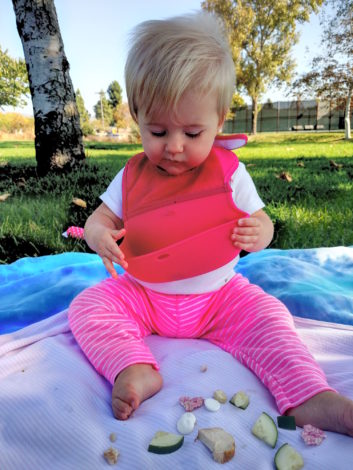Simple, Quick and Easy Outdoor Activities for Infants
We all know that it’s great to get kids outside and that nature play has a multitude of benefits, but sometimes getting out the door is difficult even if it’s just into your own backyard. If we at least have some idea of what we are going to do once we are outside, then we are one step closer. For infants, the actual activity really isn't as important as just giving your baby new experiences. These activities for infants are all simple, quick and easy and should be able to easily incorporated into your routine.

Here are some activities for infants to 1-year-olds in the great outdoors:
Hiking or Walking Outside
From just about birth, you can start getting your baby outside to hike or walk with you. Whether they are in the stroller, baby carrier or just in your arms, and whether you are hiking a trail or just walking back and forth in the driveway, getting outside and moving is a beneficial experience for you and your little one.
Tummy time, Reading or Playing Outside
Bring your normal inside activities outside to the fresh air. Grab a blanket and some books or toys and take playtime outside instead of inside. Even just napping or nursing your infant outside can feel like a new experience.
Picnics
What a better place to start your baby on new foods then outside? Sit them on a blanket and picnic together while they try out new foods and new ways of feeding themselves. Added bonus: cleanup for you doesn’t involve scrubbing floors, walls, windows or high chairs. If they still need support when sitting, try a “bumbo” type seat with a tray or just bring their high chair out with you.
Sensory Play
One of the key elements for development in babies is sensory play and the outdoors is filled with new things to explore and stimulate their senses. Let them crawl around in new terrains – grass, dirt, sand, leaves, etc. Let them pick up new materials – rocks, sticks, sand or mud. Just keep a careful eye to make sure their new finds don’t turn into their next picnic.
Get dirty
Don’t be afraid to let them get dirty! Let them squish the mud or scoot through the dirt or roll around in the grass. If you don’t want to rush to the bath tub afterwards, then move right on to one of the next activities below…
Water Play
You can take them to a pool or body of water and take them in the water with you, or fill a few bowls with water and let them splash around with their hands. Don’t overthink it – babies thrive on simplicity.
Playgrounds
During off hours, when there are not many bigger kids around, playgrounds can be perfect places for babies to work on new large motor skills, such as crawling on new surfaces, pulling up and climbing.
Bubbles
Babies love bubbles. They are easy and cheap (if you are ambitious, you can make your own following this recipe) and you are sure to get some giggles!
Balls 
One of the best toys for little ones are different sized balls for them to push around and watch bounce. Outside is the perfect place because there is nothing to hit and plenty of space. Feel free to experiment with different size balls. This will help with both gross and fine motor control.
Walking Practice
Once your little one starts trying to walk, bring them outside where there are less sharp edges and lots of softer surfaces for the inevitable spills. The only downside is that they may become more interested in a new discovery on the ground and may not get very far!
Photos Courtesy of Kirby Crawford, Ashley Scheider and Kim Ives
What are your favorite outdoor activities for infants? Share in the comments below!
ABOUT OUTGROWN
OutGrown is a 501(c)(3) nonprofit that works to create a world where everyone can enjoy the physical and mental benefits of spending time outside. We are focused on creating opportunities and removing barriers to access so families with babies and young children can take their first steps outside. We believe all families have the right to connect with nature, benefit from spending time outdoors and be inspired to a lifelong love of nature. Since its grassroots inception in 2013, OutGrown is a growing community of 280,000 families and over 300 volunteer Branch Ambassadors. More information on all of our programs can be found at WeAreOutGrown.org
EDITORS NOTE:
We hope you enjoyed reading this article from OutGrown. We’re working hard to provide our community with content and resources that inform, inspire, and entertain you.
But content is not free. It’s built on the hard work and dedication of writers, editors, and volunteers. We make an investment in developing premium content to make it easier for families with young children to connect with nature and each other. We do not ask this lightly, but if you can, please make a contribution and help us extend our reach.
Related Content





Comments